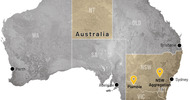Globe and Mail
How best to invest in agriculture
Ask Lawrence Asset Management's Ravi Sood in our online discussionMonday, Jan. 11, 2010
[caption id="attachment_10264" align="alignright" width="300" caption="Ravi Sood, Lawrence Asset Management"] [/caption]
[/caption]
Foodflation -- if it isn't a word, well, it should be. You've noticed the resurgent price of oil, the cold snap in the U.S. that is decimating the orange crop, and the price of sugar (YO-FT0.280.0010.39%)at a 29-year peak. Arable land per person is consistently shrinking, and finding water is a serious problem worldwide. That's all going to feed into the higher cost of breakfast.
As an investor, how can you profit from these trends? Think fertilizers, farm equipment and service providers, chemical producers and seed companies, says Ravi Sood, president of Lawrence Asset Management. Invest in food production in low-cost areas that are water-rich – Brazil, tropical Africa, Malaysia and Indonesia.
Got a question on how best to invest in agriculture? Mr. Sood will be online on Monday the 11th at noon (ET) to take your questions. Join us live at noon on Monday by clicking on the Cover It Live box below.
Investing in agriculture: Ask Ravi Sood(01/11/2010)
11:56Globe and Mail: Hello, everyone, we'll be starting our discussion shortly. I'm Sonali Verma, an editor at Globe Investor. Thanks for joining us.
12:00Globe and Mail:
Let's start with a question on how to invest in agriculture. Vikki King writes:Can you recommend some ETF's that a canadian can invest in to profit on these trends?
12:01Globe and Mail: Ravi Sood:
There are a large number of agriculture commodity ETFs in the European market and a growing number in the US. However, there are to date very few in Canada. Two that are available in Canada are:
Claymore Global Agriculture ETF (symbol is COW:TSX)Horizons BetraPro DJ-AIG Agricultureal Grains Bull Plus ETF (HAU CN)
I would recommend looking very closely at what the underlying securities are because it may or may not precisely match the exposure you are looking to add to your portfolio. For example, the Horizons BetaPro product provides levered exposure to the Dow Jones-AIG Grains Sub-Index - this is not a broad exposure to soft commodities or agriculture equities. The Claymore Global Agriculture ETF is more broad-based and likely provides a better match for the exposure you are seeking for your portfolio.12:01
Globe and Mail:We have a couple of questions from James Siggs, who writes:
In terms of primary agriculture, where do you see the biggest potential for investment in terms of geographical area and crop?How do you view the world’s stock markets' appetites for investment in agriculture over the next year?
12:03
Globe and Mail:Ravi Sood:
For many years we have seen tremendous growth in realized yields around the world, the so-called Green Revolution. In recent years, advances have decelerated and been capped in many places by several limiting factors. Most important among these are the availability of high quality land, in areas with a conducive growing climate, with an ample supply of water. Agriculture competes not just with industry but with human consumption for water and is ultimately dependent on Mother Nature for supply. Identifying areas where there is the potential for new large-scale mechanized farming that will produce economically compelling returns that also have a consistent supply of low-cost fresh water is critical. Areas that sport these features will be the new frontier in agriculture. The leading areas to-date have been Brazil and certain areas in South East Asia such as Malaysia and Indonesia. The next growth area, one that the world must turn to, is tropical Africa. There is ample underutilized land, and in certain areas a massive surplus of water.The world’s stock markets have ignored Agricultural commodities and stocks as an asset class for years. They have been the purview of legitimate hedgers and the occasional speculator but not mainstream investors.
That started to change with the massive inflation in agricultural commodities and inputs in 2007-2008 and agriculture is emerging as its own asset class. I expect that this is a permanent shift and that increasing amounts of investor attention and capital will go towards agriculture stocks and commodities.
The credit crisis of 2008 caused agricultural commodities and stocks to take a pause. However, the underlying fundamentals have not changed and in fact, have been exacerbated by a year and half of underinvestment in this critical sector. I expect this will lead to another extreme scenario where we see commodity prices overshoot to the upside due to serious short-term supply constraints. This will lead to high levels of activity and speculation in the stock market in agricultural stocks in 2010 and likely another bull run in these equities.12:03
Globe and Mail:A reader, Dale Renout, asks:
Potash: good, bad, indifferent? 12:05Globe and Mail: Ravi Sood:
Potash is a critical input in farming. The spike in food prices in 2007-8 made it economic for farmers to spend more on fertilizers such as potash that increase their yields. This, combined with loosening credit for farmers and a tightly run cartel that controls a large percentage of the world’s production led to stratospheric potash pricing in excess of $1,000 per tonne. This compares to a marginal production cost globally approximating $100/tonne. This level of windfall profit is unsustainable.
Post credit-crisis with declining food prices and declining availability of credit, farmers chose to reduce their use of fertilizers, potash in particular. This resulted in inventories being run down globally, soil nutrient levels being run down, yields being negatively affected, and approximately 20% of global production of potash being shut in. Consequently, prices have declined into the $300s per tonne. This is still a tremendous profit margin even for the highest cost producers and a function of the high capital costs required to enter the industry and the small number of large-scale producers.In 2009, China and India aggressively negotiated lower prices and have even walked away from negotiations, choosing to run down their inventories further or source potash from smaller producers in smaller one-off deals. This effort to break the cartel has, therefore, partially succeeded and is likely to embolden the buyers to negotiate harder in the future, thus putting a lid on potash prices in the next several years.
I expect that potash-related stocks will however continue to perform well. They are considered the ‘go-to’ names for most fund managers in the Ag sector, at least in North America, and tend to track the industry sentiment in general versus potash specific fundamentals. For example, Potash Corp of Saskatchewan (POT:TSX) share price is behaving very bullishly on a technical basis and I expect will continue to perform despite the fact that there will continue to be pressure on potash pricing and that the company already trades at approximately 8 x EV/EBITDA based on 2011 forecasts.12:06
Globe and Mail:Thomas Gill writes:
About a year ago I invested in some farmland in Saskatchewan at about $300 per acre. I make a small return on my investment through leasing the land but bought with the expectation that one day this land will be much more valuable. Your opinion? 12:07Globe and Mail: Ravi Sood:
Saskatchewan is a unique situation. Farmland in the province is seriously undervalued primarily due to restrictions related to the Farmland Security Act. This prevents most non-Saskatchewan investors from owning large-scale farming properties and therefore causes the prices in the province to be depressed. Some estimates show Saskatchewan farmland changing hands at less than one half the agronomically equivalent lands in Manitoba or Alberta.
There is no imminent change to the Farmland Security Act likely and so this arbitrage is not about to be unlocked in the short term. However, the economic yields on Saskatchewan land based on today's prices are the highest in Canada and prices will continue to appreciate. If you have a long-term investment horizon (5+ years) this asset is likely to appreciate significantly. 12:08Globe and Mail:
Jeremy Tabarrok writes:Is there a investment that trades on one of the exchanges that allows you to invest in farms. Sort of a REIT for farm land?
12:09
Globe and Mail: Ravi Sood: There are no such REITs in Canada and very few investment vehicles globally to directly participate in farms. Several are being designed at this time, and this is likely to be new class of investment or type of REIT that we see in the future.Due to the fragmented nature of the farming industry in Canada, it is likely that Canada will continue to lag in this regard. In the UK there are several investment vehicles listed that allow investors to participate in various emerging market farmland ventures, particularly those based in Eastern Europe.
[Comment From Jennie Helmer]
Do you have any thoughts/data on how encouraging Government to protect foodlands will actually make them more valuable as farms than housing etc?12:18
Ravi Sood:Governments to-date have been more focused on establishing food security for their nation and providing employment for the agrarian sectors of their economy - for most countries this represents the majority of their population. For example, in India, governments provide and takeaway subsidies, export duties, import duties, and generally pull other financial levers in order to meet the dual goal of food security and employment for their 600 million plus farmers.
There has been little or no attention given to strategies or methods to increase the value of farmland. Making farmland attractive as an asset class by allowing more investors to participate in it and allowing it to appreciate will drive more capital to the sector and help alleviate the world's supply problems.
12:18[Comment From Liz]
Why don't you invest your dispensable income in subsidizing small scale farmers? Farmers that know thew land and how to farm it in a way that improves soil conditions. Investing in fertilizers and chemicals is only going to deplete agricultural soils even more. Where will this leave us in the next 5, 10 years?12:22
Ravi Sood:Supporting small-scale farmers is a critical requirement in the global battle for food security. Many NGOs and other bodies have expended large sums inefficiently trying to stimulate small-scale farming. Most small-scale farmers, while knowing their land and crops intimately, are hindered by poor infrastructure, poor technology due to lack of capital for investment, and lack of access to markets where they can achieve a full and fair price for their product.
In our view, the ideal pairing is large-scale commercial 'nucleus' estates which make capital investments in infrastructure such as roads, mills, storage, and can provide these facilities to surrounding small-scale farmers. This enables them to achieve better yields, better prices, and a better living. Moreover, it has proven to be an economically viable business for these so-called nucleus estates and is therefore a sustainable model versus continued donations and subsidies.
12:25
Globe and Mail: Patrick Gervais asks:What would your investment suggestions be relating to agriculture related funds held in a TFSA or RRSP to best maximise tax shelter? More specifically, I am interested in learning about funds that hold agriculture land and that are banking on land appreciation in the next decade."
12:27
Ravi Sood:While I believe this is an excellent area to invest there is currently no attractive investment vehicle in the Canadian market that will give you that exposure in a tax-deferred account. There are several limited partnerships which have produced returns and been invested very professionally - however they are not eligible for tax deferred accounts.
You can find various investment vehicles related to agricultural land ownership in the UK market - again this is not an ideal fit for your tax deferred accounts. The best indirect investments are in broader agricultural funds or to hold tight for 2010 - we are likely to see several companies emerge that offer the Canadian investor DIRECT exposure to the appreciation of farmland. 12:37[Comment From Brian Wade]
You mention water as a supply side constraint for world agriculture. Are you aware of any companies trying to fill that well, so to speak, that you see as worthy for investment?12:39
Ravi Sood: There are several companies globally focused on precisely that shortage. One example I will provide is Jain Irrigation which provides 'drip irrigation' systems which use far less water and produce higher yields than traditional irrigation systems. Unfortunately, there is nothing compelling in the Canadian market at this time. The closest-to-home opportunity is Monsanto which is developing new strains of crops that will perform better in low-water situations.12:39
[Comment From bob]Is this a good point to get into fertilizer stock such potash and agrium and are their any cheaoer versions of these stock around?
12:42Ravi Sood:
At this time fertilizer stocks are exhibiting tremendous positive momentum and I suspect this momentum to continue. I favour Agrium over Potash but both are near or at 52-week highs and have performed very well lately. Waiting for the next 2.5% correction in these stocks which have exhibited tremendous volatility would be prudent.For a less 'expensive' alternative I would highlight Potash One (KCL:TSX). There is speculation in the market that BHP Billiton and perhaps other major mining companies will make one or more acquisitions in the potash space to expand their portfolios into this lucrative commodity. I do not believe KCL is a likely target in the short term. However, if another company or property is acquired, KCL would move sharply to the upside in speculation that the buyers would target KCL at a later date.
12:42[Comment From steve]
API and KCL, thoughts?12:44
Ravi Sood: I currently prefer KCL to API. I believe API's properties to be attractive but the stock has moved up sharply and there is definitely takeover speculation embedded in the share price.If API is indeed acquired then it will no doubt be at a premium. However, in this case I believe KCL will still outperform API on speculation buying will move to KCL with API taken out of the market.
12:44[Comment From sudarshan]
out of Agrium, Ag Growth and Viterra---what would you recommend for TFSA12:45
Ravi Sood: I would strongly recommend Ag Growth International for a TFSA.It has an attractive yield over over 5%. It has demonstrated growth in North America and is advancing its growth strategy globally. Its product lines are all very well placed versus market demand and if they achieve success internationally it could translate to tremendous earnings growth for the company. it is my top pick among domestic agriculture-related equities.
12:45[Comment From John Booth]
I found your comments on Sask farm land very interesting - are you familiar with Assinaboia as an investment vehicle for exposure to this?12:47
Ravi Sood:Assinaboia is a professionally managed investment vehicle that provides exposure for qualified investors to precisely this growth potential. Saskatchewan is constrained by the Farmland Security Act but there is a major investment opportunity for those that can make a long-term investment through professionally managed vehicles. It would be very good for Canadian agriculture to see publicly traded farmland REITs to develop to provide access for investors and capital for farmers.
12:47[Comment From Calvin W]
based on an earlier comment are you suggesting to buy farmable land while we can and if so where in the world should we be buying it? We are irrigation farmers in southern Alberta12:52
Ravi Sood:In 2006-8 various funds were formed to pursue investments in agricultural land. Most were focused on South America (Brazil, Argentina, Uruguay) and Eastern Europe including Russia. Some were focused on 'frontier' markets in south east asia and Africa. Most have peformed poorly because they were driven by financial investors and operated by financial engineers. The successful ones were driven by farming professionals. My firm has investments in farmland in 3 areas - Saskatchewan, Uruguay, and Africa (DRCongo).
Saskatchewan is attractive because of large land packages available in attractive irrigation districts. Uruguay is interesting because the soil quality is high, access to water excellent, and land prices are discounted versus Brazil and Argentina on either side. This arbitrage will disappear soon. Tropical Africa, The DRC in particular, is attractive because it closely approximates Brazil on a climate, water, soil basis and the land values are anemic compares to Brazil or anywhere in South America.In all cases, we believe we will be successful because our investments are managed by on-the-ground professional farming management teams with decades of experience in their own markets. Investing simply as a financial investor in such markets is not a successful strategy in our view.
12:54
[Comment From m.s.gill]what province is the best province to invest in farm land and why?
12:55Ravi Sood:
All land is not created equal. We would consider each property available for sale as a unique, living, breathing entity. Access to infrastructure, typical heat patterns, soil quality and considerations, and access to water are all important and vary even within each province.Generally speaking the best values for large-scale arable farming are in Saskatchewan however.
12:57
Globe and Mail: Sonali Verma: Ravi, thank you for all your time. Is there anything else you'd like to say before we conclude our discussion for today?12:59
Ravi Sood:We believe that the trends that have emerged in recent years in agriculture are very-long term in nature and represent a compelling investment opportunity. The trends of urbanization, population growth, and increasingly scarce resources are accelerating and there will be many investment opportunities in this sector for years to come.
12:59Globe and Mail: Sonali Verma: Thank you. And thanks to everyone who joined us today. Can't wait to do it again .
12:59












